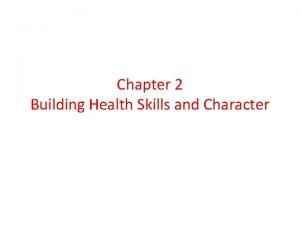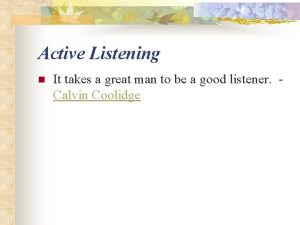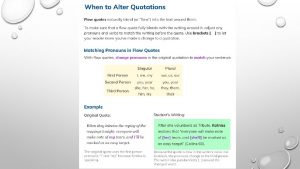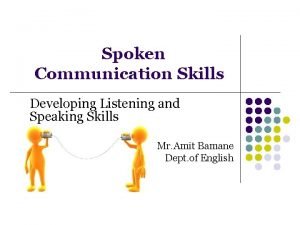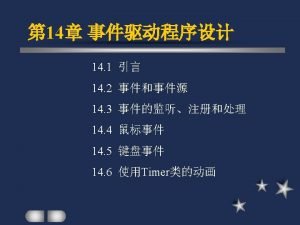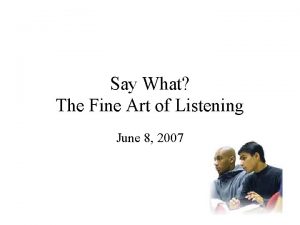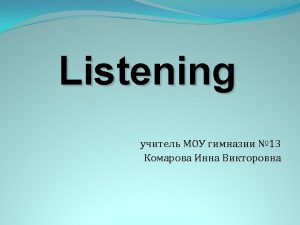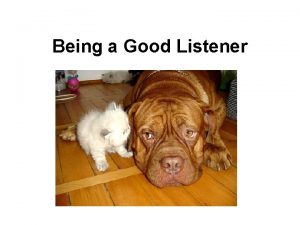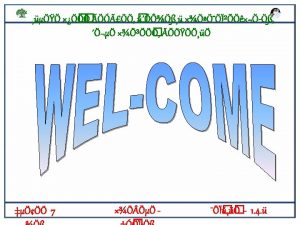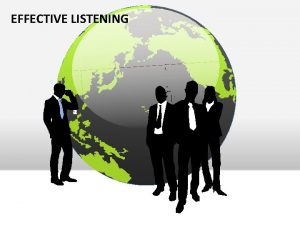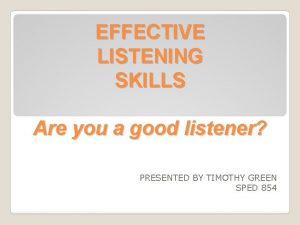Characteristics of a good listener A good listener




















- Slides: 20

Characteristics of a good listener • A good listener listens to the whole message, including the specific point the speaker is trying to make. • A good listener thinks about the speaker, not himself or herself. • A good listener pays attention to what is being said. • A good listener maintains eye contact

• A good listener does not interrupt. • A good listener asks questions when appropriate. • A good listener is open to other points of view. • A good listener shares impressions with the speaker to confirm the message. • A good listener does not let personal beliefs or feelings interfere with listening to the message and understanding it.

Personal contacts Some one please read that paragraph.

Communication break downs A. Think of communication as process 1. a though or idea is encoded into words or actions 2. the “coded” message” is transmitted 3. the message is decoded and interpreted

B. Communications break downs can occur in all 3 steps of the process. • During the thought or • During the decoding of the message or • During the interpretation Example…

C. Common hindrances to communication • Poor timing: 1. you are not paying attention 2. You are too busy 3. Disturbances, preoccupations 4. Doing something else 5. Multitasking

• Suspicion 1. The way they look 2. You are scare 3. Dislike 4. Hostility 5. Intimidated • Poor communication skills 1. Other language 2. Unable to express ideas

• Preconceived notions 1. You already know what they are going to say ( yea, he or she always…. ) 2. Stereotypes • Insufficient explanation 1. Do not Ask questions 2. Do not know the whole story

• Too many people involve 1. He said 2. She said 3. The more people involved the less accurate the information. Remember there always 3 sides to a story – Your – Theirs – And the truth • Failure to acknowledge another's point of view. 1. Is my way or …. .

Methods for preventing communicating breakdowns 1. 2. 3. 4. Send a clear message (think before you speak) Get the facts (ask questions) Minimize environmental distractions (timing is everything) Increase the likelihood of your message being received and interpreted correctly (use different types of communication) 5. Emotions mean as much as facts (do not let your emotions take the best of you) 6. Defensive behavior is less conductive to communication than supportive behavior

Defensive behavior • • Evaluating Controlling Strategy Superiority Blame others Negative Always right

Supportive behavior • • • Descriptive Positive Problem solver understanding Empathy Equality Open minded Sensitive Good listener Eye contact


You have the right to remain silent

1. Take responsibility for your own communication (don’t blame others) 2. Establish a common goal (look for the other person’s wants and needs as well as your own. 3. 4. • • • Truly care. Build rapport by matching: Tone of voice Key words and phrases Body language

5. Solve problems by working together. • Let the problem the goal and the solution unfold by asking questions. • Ask, don’t tell!

Handling difficult situations effectively A. When an angry individual confronts you, try to get that person settled down as quickly as possible 1. Calm the person down – – Let them talk (offer them something to drink) Take notes Paraphrase what they are saying If possible have someone else there as witness

2. Immediate response or commitment to action I not necessary. – You do not have to give them an answer right away. – Ask them for input, what would they like done. 3. Investigate the real cause of the problem, then deal with the real issue. – Ask questions – What is it that you really need? – Who? , where? , when? , how?

4. Fallow up – Either with a letter or – Phone call – Make sure you document how the situation was solved B. most of the same techniques can be use if an angry individual calls on the phone. c. It is never acceptable to listen to abusive or obscene language in person or on the phone

D. Recognize your own shortcomings: In conclusion 1. 2. 3. 4. 5. When dealing with confrontations. Calm the person down Express desire to help Listen, do not argue Respond with positive decisions or actions Fallow through. Above all remain …. . Calm and professional
 Good listener
Good listener It takes a great man to be a good listener meaning
It takes a great man to be a good listener meaning Fabric event listener
Fabric event listener Speaker listener plot clue
Speaker listener plot clue Listening to music alone is so peaceful :)
Listening to music alone is so peaceful :) Database listener
Database listener Purposeful
Purposeful Active vs passive listening
Active vs passive listening Gui event types in java
Gui event types in java A speaker's mand is an sd for the listener to act.
A speaker's mand is an sd for the listener to act. Balance the workload across two or more it resources.
Balance the workload across two or more it resources. Ros tf listener
Ros tf listener It is the spoken communication
It is the spoken communication Swing component
Swing component Component listener
Component listener Listening strategies activities
Listening strategies activities Event
Event Content oriented listener
Content oriented listener Java fx calculator
Java fx calculator Java listener
Java listener Jlist listener
Jlist listener
